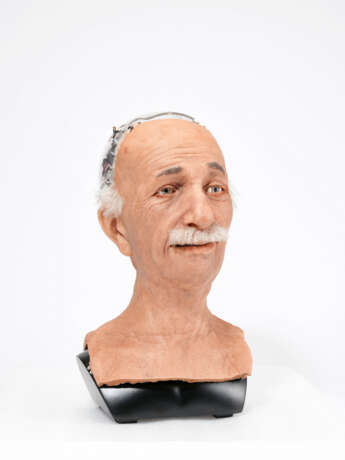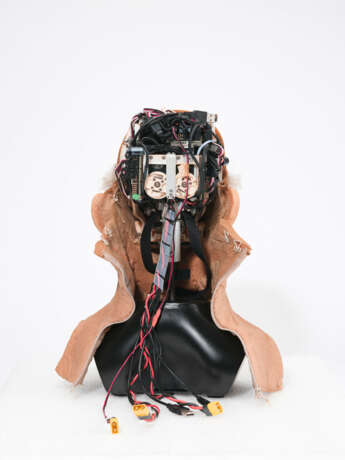ID 1353366
Lot 38 | Einstein: pioneering robotic head
Valeur estimée
£ 100 000 – 150 000
Robotic head, with 28 servo motors for face movements and 3 servo motors for neck movements, linked at various points with Teflon-coated nylon strings, with Hanson 'Flubber' covering
16in. (40.5cm.) high
The Einstein by Hanson robotic head, developed by Hanson Robotics in 2005: a landmark achievement in robotics and artificial intelligence.
This innovative creation blends advanced mechanics with a distinctly human-like visage modelled after the renowned physicist Albert Einstein. His likeness was constructed using Frubber, a flexible, skin-like material developed by Hanson Robotics, while various motors inside the head made it capable of performing a range of facial expressions. Indeed, with over thirty-five actuators in the head alone, the robot could mimic human facial movements with remarkable accuracy, including nuanced expressions around the eyes and mouth. The human-like facial expressiveness made Einstein by Hanson one of the first robots to evoke empathy and a sense of personality, going beyond mere mechanical functionality. This was both a hand-sculpted work of art and a work of cutting edge technological innovation, resulting in numerous patents, awards, and scientific papers on the subject of AI mechanisms for synthetic facial expressions and human-robot interactions.
Built for a collaboration between Hanson Robotics and the Korea Advanced Institute of Science and Technology, Einstein by Hanson was mounted on a life-size walking robotic body to become Albert HUBO, the first fully capable Android. Winner of the Smithsonian Cooper Hewitt design award, it was a star of the Cooper Hewitt Design Triennial from 2006 to 2008. The Einstein robot served further AI research at the University of California at San Diego Machine Perception Lab at the UCSD Institute for Neural Computation and, in 2008, appeared in a TED talk in 2008 by David Hanson, founder of Hanson Robotics. It has since continued to serve research inside Hanson Robotics R&D in human-robot interaction, artificial intelligence and towards the development of the famous Sophia Robot.
Albert HUBO’s impact extended beyond engineering circles and entered the realm of popular culture and politics, most notably when it met former President George W. Bush at the Asia-Pacific Economic Cooperation (APEC) summit in 2005. This moment garnered significant media attention, symbolizing advancements in robotics and artificial intelligence and their potential for bridging cultural and technological divides. Albert HUBO's ‘encounter’ with Bush served as a powerful moment in robotics, and the lasting impact of this conference led to Albert HUBO being featured as the January 2006 cover star of Wired magazine celebrating his position as no.17 in their list of '50 Best Bots Ever'.
Einstein by Hanson marked a significant step towards a public understanding of robots as not just functional, but relatable, and capable of human-like expressions. Indeed, Einstein by Hanson, and its later-developed sister Sophia, has served as inspiration for various science fiction productions, from Ex Machina to Westworld, where AI-driven, lifelike machines challenge human perceptions of intelligence and autonomy. Albert HUBO's lifelike expressions and Einstein-inspired design have left a lasting cultural legacy, foreshadowing a future where humanoid robots might interact seamlessly with their human counterparts in the real world, from education and healthcare to entertainment and domestic life.
| Lieu d'origine: | Hong Kong |
|---|---|
| Catégorie maison de vente aux enchères: | Instruments |
| Lieu d'origine: | Hong Kong |
|---|---|
| Catégorie maison de vente aux enchères: | Instruments |
| Adresse de l'enchère |
CHRISTIE'S 8 King Street, St. James's SW1Y 6QT London Royaume-Uni | |
|---|---|---|
| Aperçu |
| |
| Téléphone | +44 (0)20 7839 9060 | |
| Commission | see on Website | |
| Conditions d'utilisation | Conditions d'utilisation |








